Every solo traveler has probably considered backpacking Europe in a month. However, some travelers never book their flight because they become overwhelmed with planning their one-month Europe backpacking itinerary.
Using my experience from solo traveling Europe, I have compiled an extensive one month Europe backpacking itinerary. This itinerary is perfect for a first-time European traveler who wants to visit as many countries as possible while staying on a budget.
I will answer many important questions about solo backpacking in Europe in this blog post. Also, I will share important information regarding cost and safety. Then, I will share my one-month itinerary for Europe, including information on where to stay and what to do in each location.
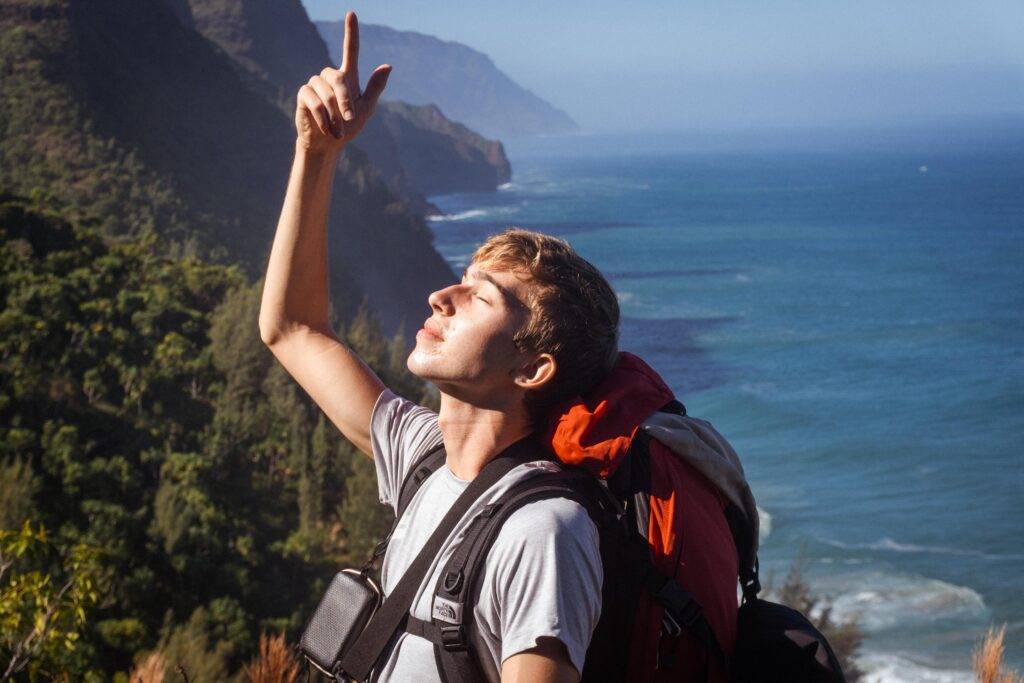
Hi, I am Noah takes the world. I love solo traveling. Planning a solo trip can be stressful with endless scrolling and searching.
My mission is to make your solo trip a reality.
Subscribe to my monthly newsletter—stunning photos and stories to guide your solo trip
This post may have affiliate links. I receive a small percentage if you book a hostel or attraction through my recommended links. This is at no extra cost to you and helps me reach my goal of becoming a full-time digital nomad.
- How Many European Countries Can You Visit in One Month?
- What Time of Year Should You Backpack Europe?
- Can You Backpack Europe in a Month?
- Is It Safe to Solo Travel to Europe?
- How Much Does It Cost to Backpack Europe for One Month?
- Why Do You Need a Eurail Pass to Backpack Europe?
- Day 1-3: Fly to Barcelona and Explore Its Art Scene
- Day 4: Continue Along the Mediterranean Coast to Marseille
- Day 5-7: Hike in Cinque Terre
- Day 8-10: Join the Crowds In Rome
- Day 11: Head North and Stop by Venice
- Day 12: See the Sound of Music Sights in Salzburg
- Day 13-14: Hike in Zurich
- Day 15: Head to Germany to See the Neuschwanstein Castle
- Day 16-17: Take the Train to Munich and Prague
- Day 18-19: Go back to Germany and Visit Berlin
- Day 20: Spend the Day in Amsterdam
- Day 21: Explore Brussels
- Day 22-24: Pass by Luxembourg and Then Paris
- Day 24-26: Take in Museums and Music in London
- Day 27-29: Hike in Edinburgh and ride the train to Holyhead
- Day 30-31: Finish Your Europe Trip in Dublin
- The Perfect One-Month Europe Backpacking Itinerary
How Many European Countries Can You Visit in One Month?
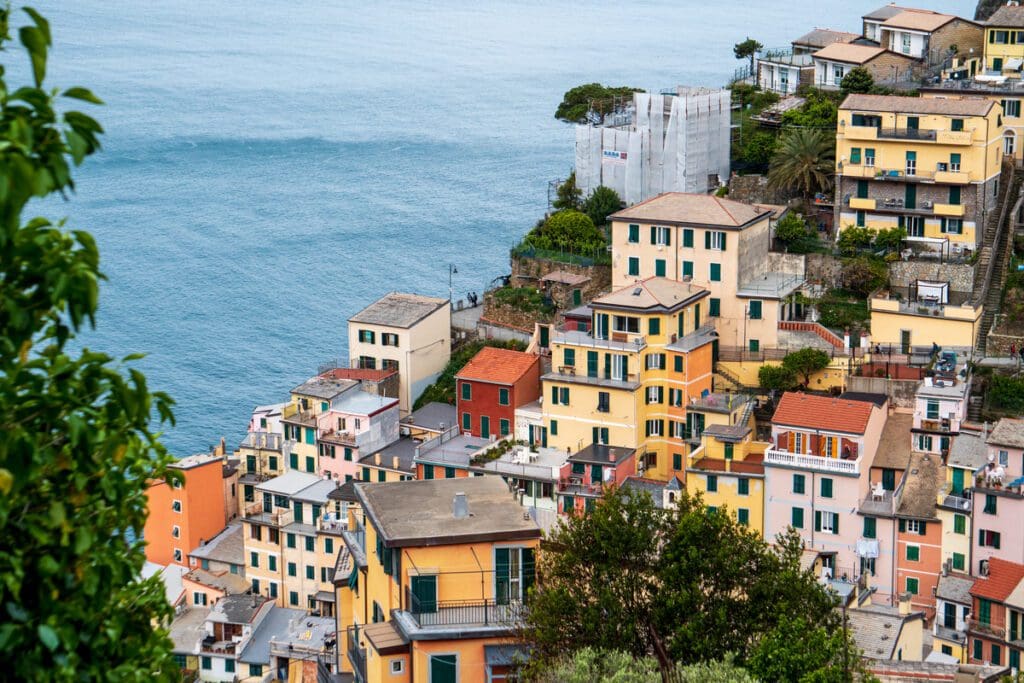
If you are willing to travel a few hours every few days by train, you can expect to visit around 8 countries during a month’s European visit. If you prefer to travel slowly, you will only enjoy visiting around 5 countries during a month-long backpacking trip to Europe.
However, you can visit more than 10 countries during a month’s trip if you are willing to travel at least four hours every few days by train. During my one-month Europe backpacking trip, I visited 13 countries in one month because I maximized layovers, took overnight trains, and never backtracked.
Want to Visit Eastern Europe? Read My One Month Balkans Travel Itinerary: Visit 6 Countries Without A Car
What Time of Year Should You Backpack Europe?
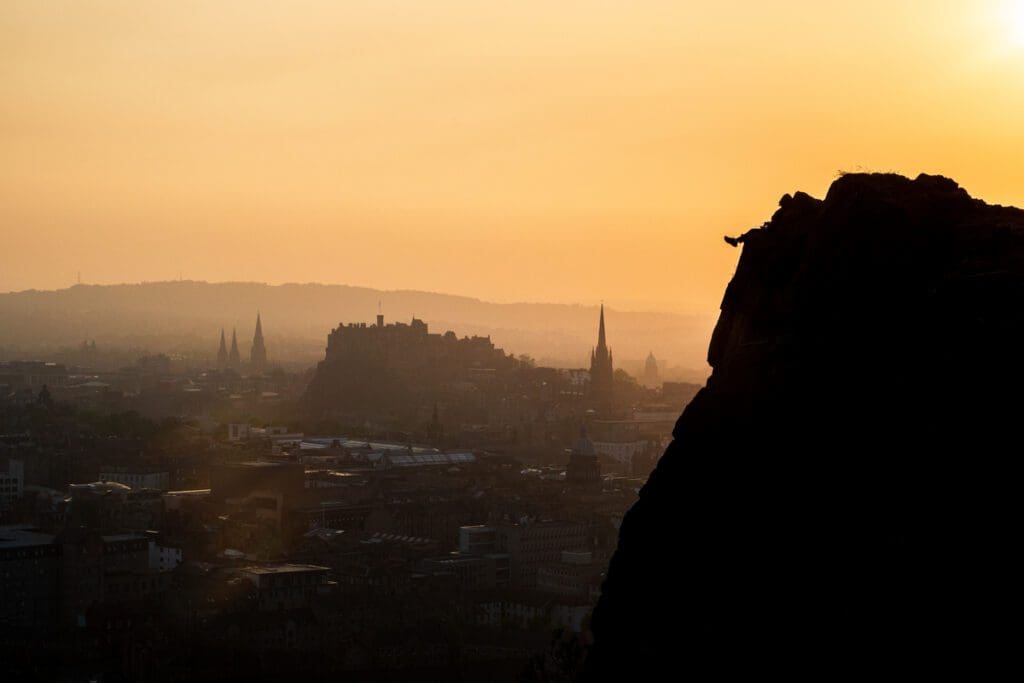
From June to August, Europe becomes extremely crowded due to tourism. Hostel prices rise, and popular attractions sell out fast. Therefore, it is recommended to avoid taking a backpacking trip to Europe in the summer, unless you are going to more remote locations in Europe.
Visiting Europe in late spring (April and May) is ideal because you will still have warm weather but without as many crowds. September and October are also good months to visit since there will be fewer crowds and still some mild weather. If you visit during the winter months, you will see even fewer people, but the weather will not be as ideal.
Can You Backpack Europe in a Month?
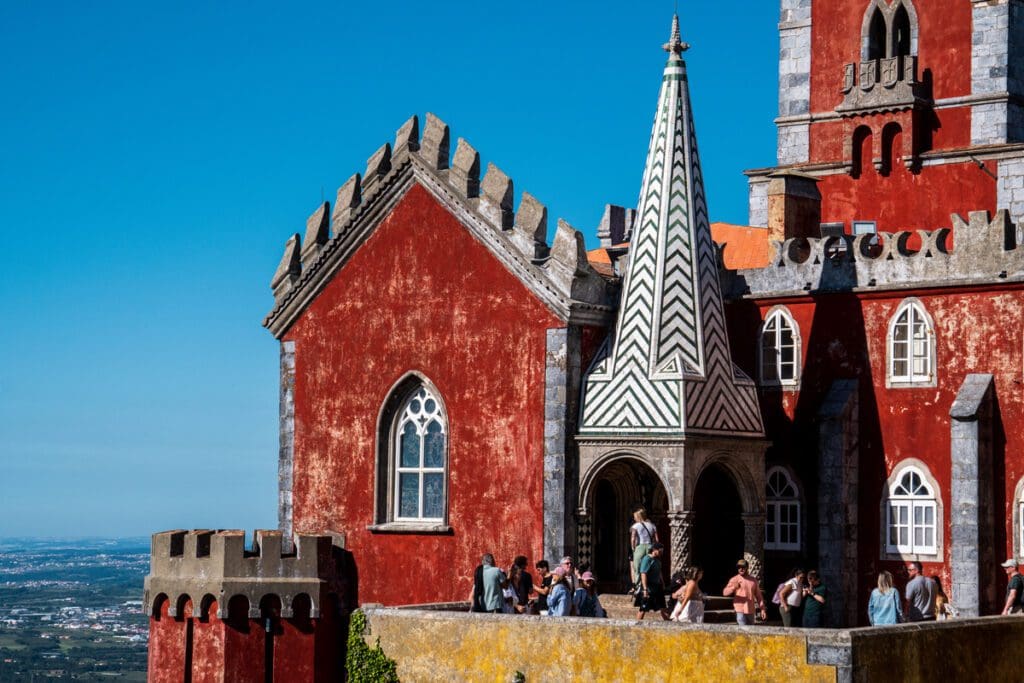
Some solo travelers wonder if trying to backpack Europe in a month is worth their time. You can easily backpack Europe in a month, but I recommend deciding where you plan to go before your trip starts to ensure you can reach all your desired destinations before your trip ends.
A month gives you enough time to visit major cities and to take a few trips into more remote areas. It is good practice to use your travel days as rest days. This means you rest and relax while on the train traveling to a new destination instead of spending your time resting in a hostel.
Is It Safe to Solo Travel to Europe?
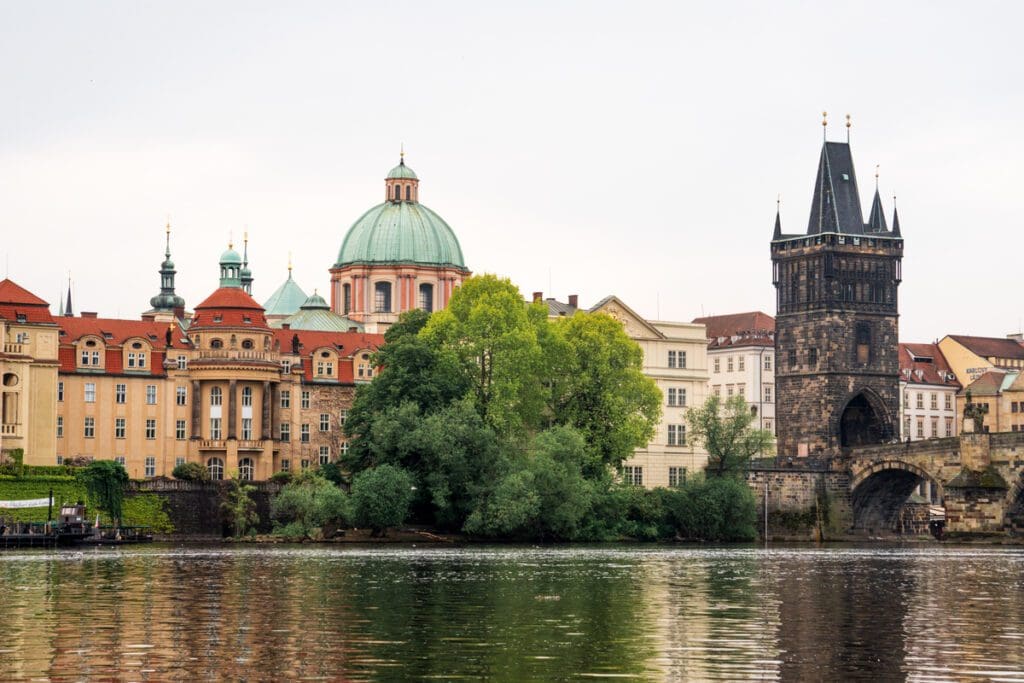
Europe is one of the most popular destinations in the world for solo traveling. Because of a robust tourism industry and reliable public transportation, it is safe to travel alone in Europe.
However, pickpocketing is very common because of Europe’s robust tourism industry. Pickpockets rarely turn violent, but whenever you are in an area that attracts foreign tourists, you should watch out for pickpockets.
You do not need to be fearful when traveling to Europe, but always remain vigilant to avoid someone stealing your things. I highly recommend always having your phone and wallet in a zipped bag close to your body, where you can see them.
I always recommend that solo travelers purchase travel insurance before going on their trip. You never know when you will need it! (You could get food poisoning in Japan, like I did). Use the widget below to find the plan that best suits your needs.
How Much Does It Cost to Backpack Europe for One Month?

Depending on your spending habits, you will need around $3,000 to $5,000 USD. You can expect your flight and Eurail Pass to be around $1,000 to $1,500 USD. Attractions and food for a month will be about $1,000 USD. Finally, accommodation will be close to $1,000 USD.
I only spent $3,000 when I backpacked Europe for one month because I limited my spending. I typically bought food from supermarkets for my breakfast and lunch. Also, I barely spent any money on shopping since I only had a backpack and did not want to add more weight to my pack.
Why Do You Need a Eurail Pass to Backpack Europe?

You do not need to have a Eurail Pass to Backpack Europe, but it is highly recommended if you visit many countries. A Eurail Pass is a special train ticket that allows you to take almost any train in Europe.
Some popular and fast trains require a reservation with your Eurail Pass, typically costing around 5-10 Euros. However, the pass covers local and regional trains completely with no additional fee
A Eurail Pass is typically the most cost-effective option if you plan to cover long distances during your European backpacking trip. However, the biggest appeal of a Eurail Pass is convenience. Instead of queueing in long lines at train stations to buy tickets, you can add a ticket to your phone using the Eurail Rail Planner App.
There are many different types of Eurail Passes. Some passes last for a month but only give you 10 travel days. This means you can travel only 10 days a month. Instead of dealing with the stress of running out of travel days, I purchased a continuous month pass, giving me unlimited train travel during my entire trip.
Day 1-3: Fly to Barcelona and Explore Its Art Scene
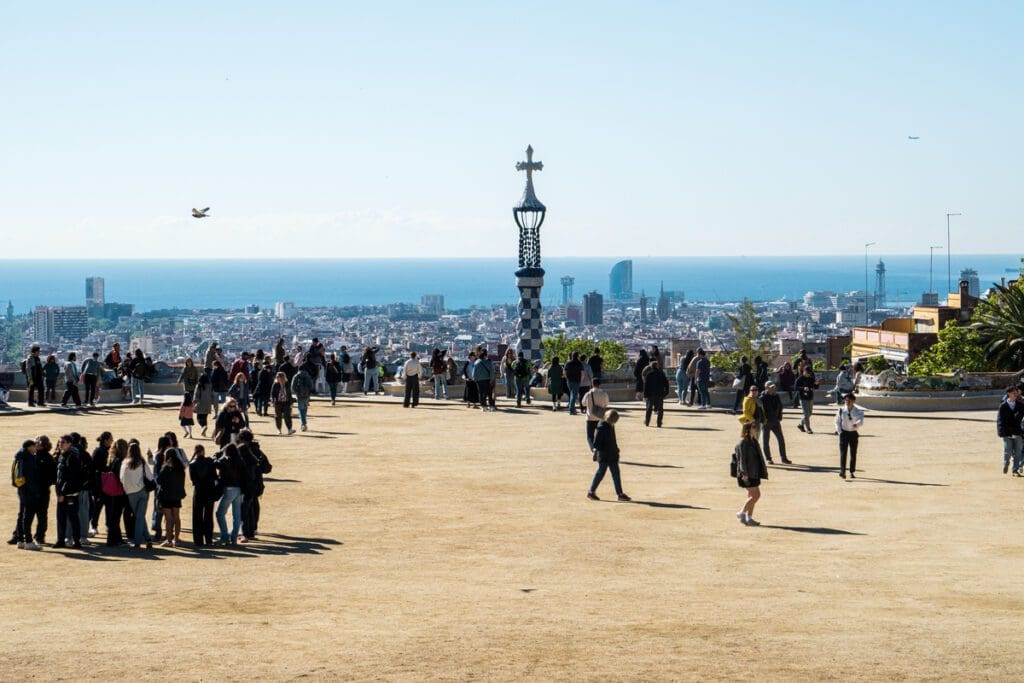
On my one-month Europe backpacking itinerary, Barcelona is the first stop since it is on the western edge of Europe. It is also an ideal place to start your journey since it is one of the cheapest European cities to fly into.
I recommend spending at least two nights in Barcelona. I only spent one night in Barcelona when I backpacked Europe for a month. I wish I had spent longer in this vibrant city.
How to Access
I flew Tap Air Portugal to Barcelona from Chicago because it was hundreds of dollars cheaper than other flights and allowed me to have a free 12-hour layover in Lisbon, Portugal. My ticket also included a free carry-on and personal item. Other budget European airlines like Norse Atlantic do not include a free carry-on.
Where to Stay
I stayed at Sant Jordi Hostels Gracia. The hostel is located in a quiet part of Barcelona, near the famous Park Guell. This hostel is perfect for the solo traveler who wants to stay in a less commercialized part of the city.
What to Do

Barcelona is one of my favorite European cities because of its ideal location on the Mediterranean coast and exquisite art scene. A perfect day in Barcelona would be to start at Park Guell at 9:30 am (to avoid crowds that quickly form in the park). Then, get lunch at Mercado de La Boqueria and finish your day at the Montjuic Castle.
When in Barcelona, you cannot miss seeing La Sagrada Familia, one of the most captivating churches in all of Europe. Also, I highly recommend people watching in Ciutadella Park and touring the Gothic Quarter.
Day 4: Continue Along the Mediterranean Coast to Marseille
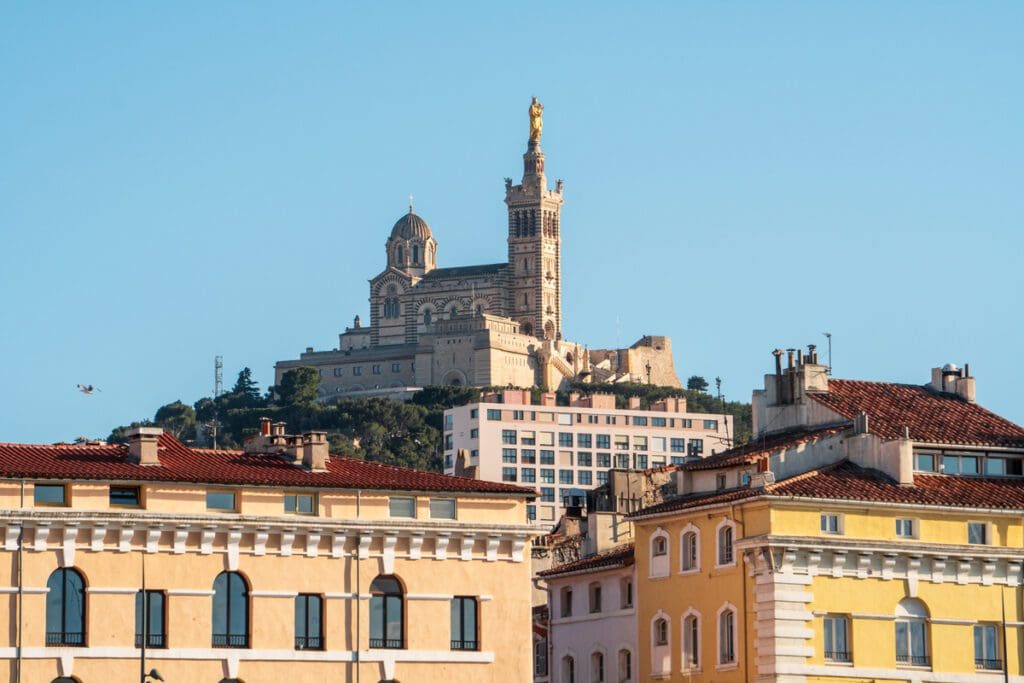
After enjoying Barcelona, I recommend heading towards Cinque Terre, an iconic national park in Italy that is all over social media. However, you should first stop for the night in Marseille, France, since Barcelona and Cinque Terre are somewhat far from each other.
Marseille is not the most aesthetic city, but it is intriguing. The city is very dense and lively. Plus, there are plenty of places here where you can soak in the sun and watch the waves crash.
How to Access
Without paying any seat reservations, you can reach Marseille from Barcelona using your Eurail Pass in about 9 hours with 2 transfers. If you are willing to buy a seat reservation for about $10, you can reach Marseille in less than 5 hours. So, I would recommend buying a seat reservation.
You can buy seat reservations on the Eurail Rail Planner App.
Where to Stay
When I stopped in Marseille during my one month Europe backpacking trip, I stayed at the People Hostel Marseille. The hostel was spacious and clean with a lively courtyard. I also loved that my bed had curtains for enhanced privacy.
What to Do

If you are just having a layover in Marseille on your journey to Cinque Terre, you will not have much time to explore the entire city. However, you will have time to hike up to the Basilica of Notre Dame for sunset and to stop by the edgy district of Noailles for dinner.
If you have more time to spend in Marseille, you should also photograph the waves crashing at Plage de la Pointe d’Endoume or Plage de Maldormé.
Day 5-7: Hike in Cinque Terre
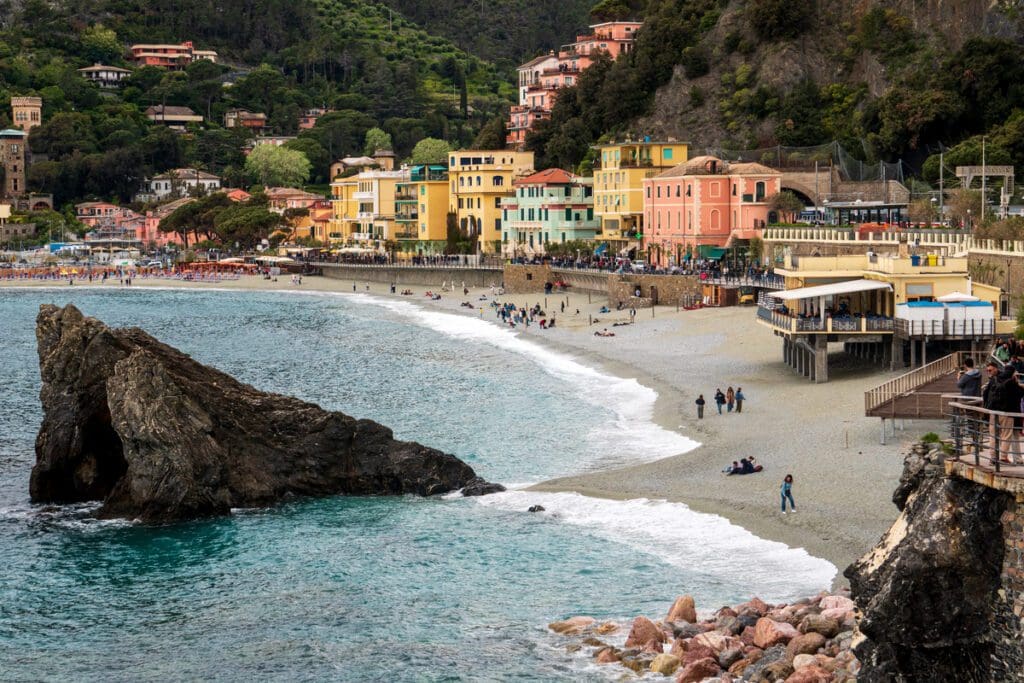
Cinque Terre is one of the premiere spots for hiking and sightseeing along the Italian coastline. You can traverse steep cliffs to weave through the five historic villages of Cinque Terre. For travelers who don’t want to hike, there are also trains that connect all five seaside villages.
Cinque Terre is one of the most stunning places featured in my one month Europe backpacking itinerary. However, it is not the most tranquil spot in my itinerary. You can expect a lot of crowds in Cinque Terre, especially during warmer months.
How to Access
From Marseille, it will take about 8 hours on local trains to reach La Spezia, the most popular town for starting a trip in Cinque Terre. You will have to change trains 3 times. It is important to allow at least 15 minutes between train transfers because trains in Europe are sometimes delayed.
Although it is a long journey to Cinque Terre, it is a scenic train ride that hugs the coastline. You can use the time on the train to rest and prepare for hiking in Cinque Terre.
Where to Stay
I stayed at Ostello Tramonti when I visited Cinque Terre. This budget hostel is the cheapest place to stay in Cinque Terre. It has its own restaurant, perfect for socializing and making new friends.
However, the hostel is in Biassa, a small village in the mountains between La Spezia and Riomaggiore (the first of the five villages). The only way to Biassa is via a local bus from either town. You must pay special attention to the bus times because they only run a few times daily.
What to Do
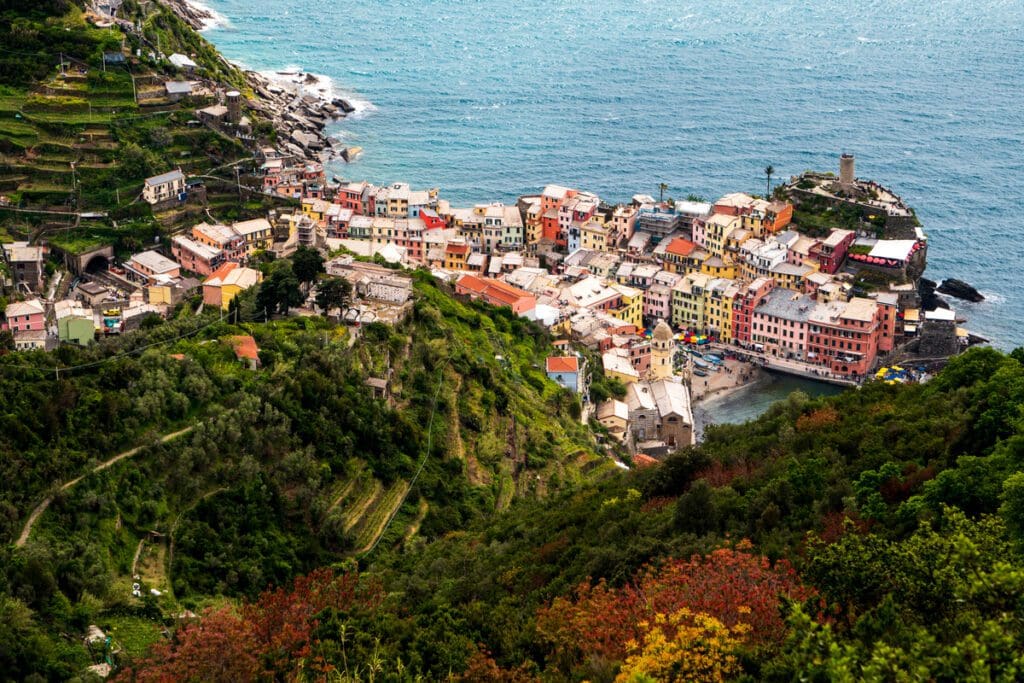
Cinque Terre gets very busy, but there are ways to avoid the crowds. Wake up early and hike 4 miles from Biassa to Riomaggiore (here is the trail map). I only ran into a few other fellow hikers when I hiked this trail.
Once you reach Riomaggiore, get breakfast at Panificio Rosi and take the train to Monterosso, a Cinque Terre village known for its impressive beaches. Monterosso gets crowded fast, so it is ideal to get here early.
Many travelers hike the famous blue trail from Monterosso to Vernazza, but it requires an entry fee. To bypass the crowds and avoid paying an extra fee, take the more challenging high trail from Monterosso to Vernazza. Taking the high trail was the highlight of my trip to Cinque Terre.
Day 8-10: Join the Crowds In Rome

Rome is one of the most “touristy” destinations in Europe. Although I typically like to avoid areas that deal with over-tourism, Rome has too much history to overlook. If this is your first time visiting Europe, you must stop by Rome. Plan to wake up early each day during your trip to beat the crowds.
How to Access
From La Spezia, you can take a regional train to Rome in about 5 hours. However, you might have to change trains in Pisa. You can also visit Pisa along your way to Rome, but I do not think it is necessary or that enjoyable.
Where to Stay
I stayed at YellowSquare Rome when I visited Rome and highly recommend the hostel. They offer you a free drink token you can use at their bar across the street. Plus, the facilities are very clean and modern.
They have laundry machines and cheap lockers you can use after you check out. If you want to save money during your stay, you can cook in their spacious kitchen.
What to Do
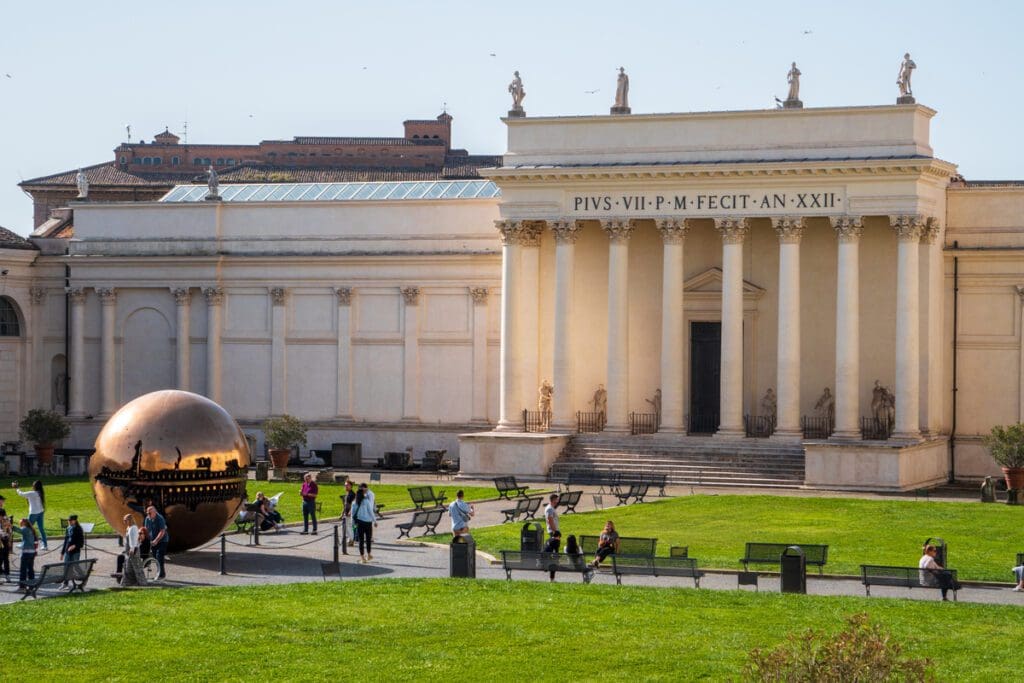
Rome is full of so many iconic attractions. Some of them are underwhelming, but many of them are unforgettable. You can’t miss touring the Colosseum. Just purchase tickets ahead of time. The line to enter the Colosseum gets infamously long. The Sistine Chapel and Vatican Museums are also a must-do, but they require a large chunk of the day, which is not ideal for a quick trip to Rome.
Although Rome has many paid attractions, there are great things to do in the city for free. Wake up early to worship at the St. Peter’s Basilica and watch the sunset from Janiculum Hill. If you get hungry in Rome, get delicious 5 Euro pasta from Pastificio Guerra and taste legendary gelato from Giolitti.
Day 11: Head North and Stop by Venice
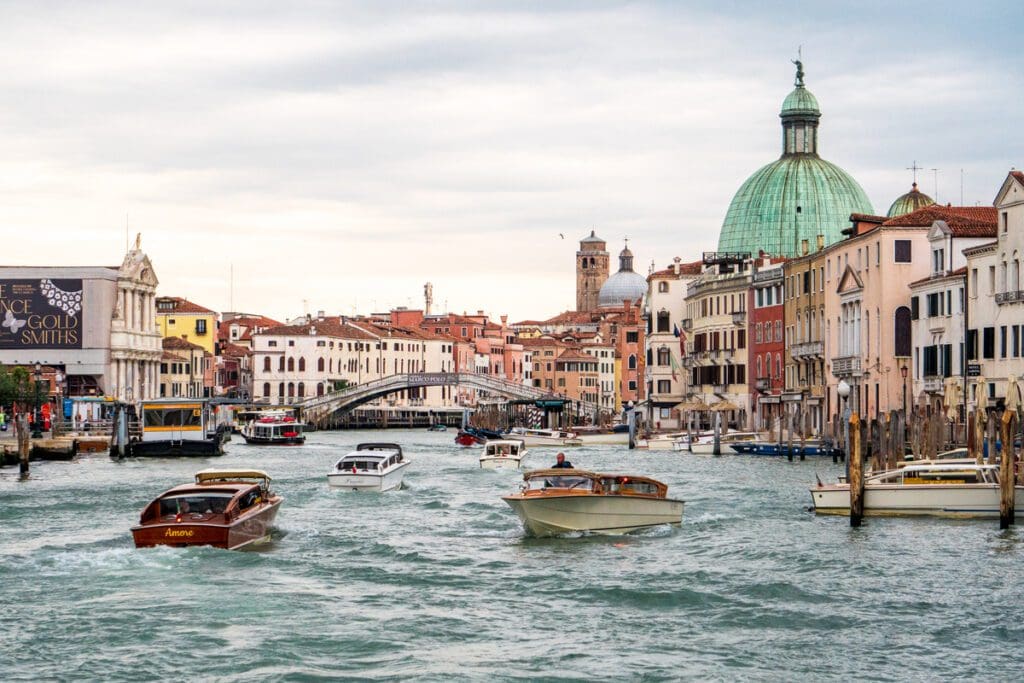
After you have spent about a week soaking in the sun near the Mediterranean, it is time to head inland towards Austria. Since you are traveling by train, reaching Austria will take some time. Therefore, I recommend stopping at Venice to break up the travel time.
Venice, like Rome, is dealing with overtourism. On certain days of the year, you must pay an access fee if you visit Venice on a day trip. However, if you stay overnight in Venice, you do not need to pay the access fee.
Admittedly, Venice is one of my least favorite places on my one-month Europe backpacking itinerary because it is uber-touristy. However, there are spots in Venice that are magical and calming; you just have to get off the tourist trail.
How to Access
The best way to get from Rome to Venice on a budget is to book an overnight train. For a second-class seat, I only paid $5 USD for a seat reservation. However, I did have to sleep on a train seat that did not recline for 6 hours, which was not ideal.
Where to Stay
I recommend staying at Anda Venice during your quick stop in Venice. Although this hostel is not located on the island of Venice (you will have to take a train to reach the island), it has great amenities for the price.
Another reason to stay at Anda Venice is that it is only a block away from the Venice Mestre Train Station.
What to Do
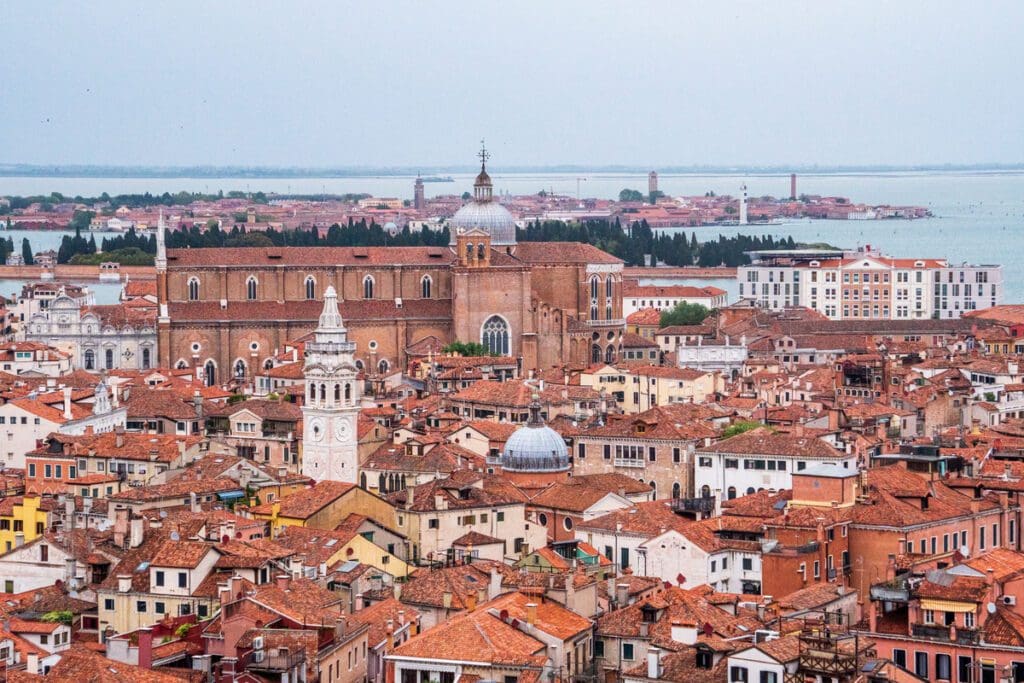
Start your day early in Venice at the iconic Ponte di Rialto Bridge. Then, visit the Saint Mark’s Basilica when it opens at 9:30 am. Get coffee and sweets from Pasticceria Tonolo and go to Chiesa Parrocchiale di San Pantalon, a church home to the world’s largest canvas painting.
Towards the afternoon, I recommend taking a nap at your hostel to avoid crowds and to rest if you took the overnight train to visit. Head back out to the free T Fondaco Rooftop Terrace. Just book your tickets beforehand. Next, walk around the Arsenale di Venezia, a more calming part of Venice. Finally, finish your day watching the sunset on top of the St Mark’s Campanile.
Day 12: See the Sound of Music Sights in Salzburg
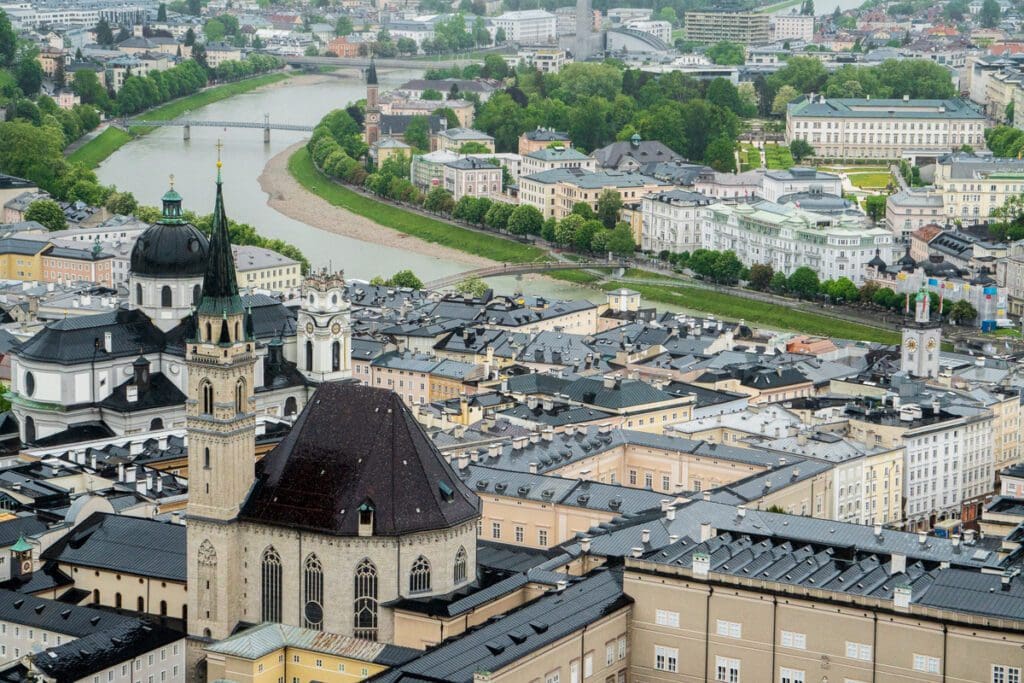
Before venturing into Switzerland and Germany, stop for a night in Salzburg. This romantic castle town attracts many foreign tourists eager to visit iconic “Sound of Music” filming locations.
How to Access
The easiest way to access Salzburg while utilizing your Eurail Pass is to take a train to Villach, Austria. In Villach, you will have a two-hour layover, and then you can take the next train to Salzburg.
Villach is a quiet, walkable town with shopping, perfect for a quick layover. In total, the journey will take about 8 hours. So, I recommend leaving Venice as early as possible, so you can maximize your short time in Salzburg.
Where to Stay
A great place to stay on a budget in Salzburg is the International Youth Hostel. It is located near many famous tourist destinations in Salzburg. You can meet fellow travelers during the hostel’s nightly screening of “The Sound of Music.”
What to Do
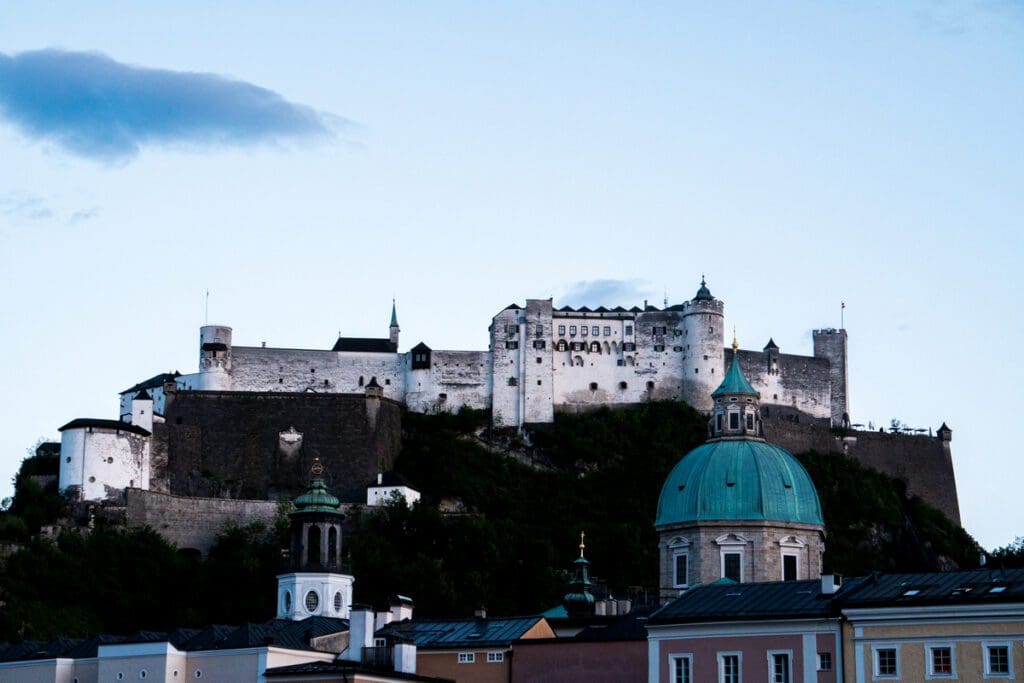
Among the most famous landmarks in Salzburg is the Fortress Hohensalzburg. This 11th-century castle complex overlooks Salzburg and is easy to reach by foot from Salzburg’s Altstadt (old town)
You can also tour the Mirabellgarten and shop along Getreidegasse. Some other notable sites in Salzburg include Universitätsplatz, a famous plaza, and the Salzburg Cathedral.
Day 13-14: Hike in Zurich
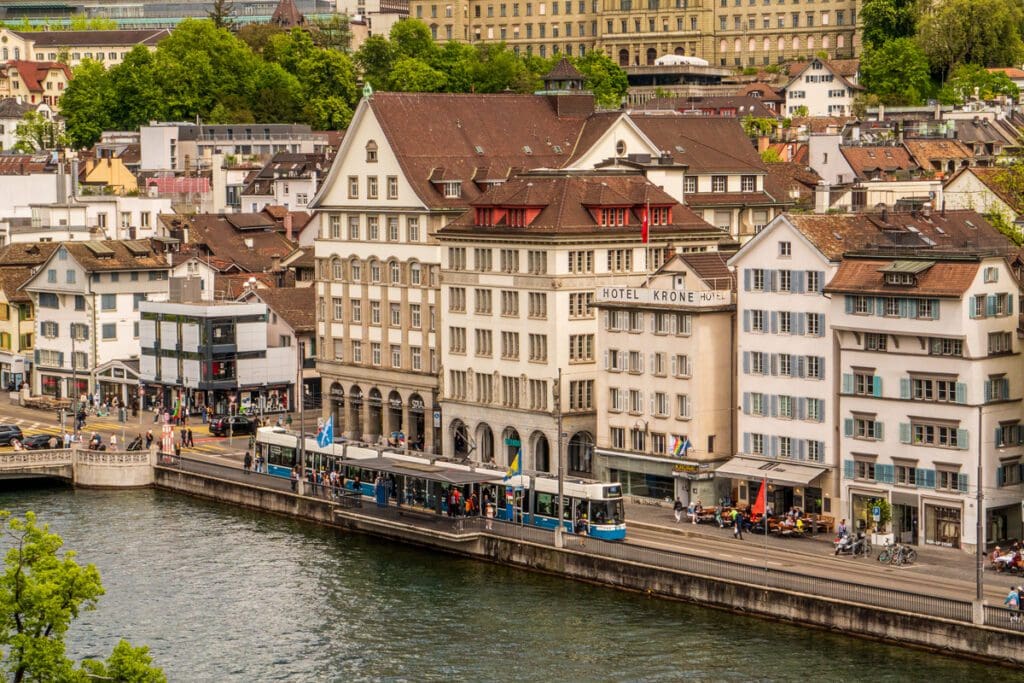
After touring Salzburg, take a scenic train ride to Switzerland. Although the true beauty of Switzerland is found in the Alps, I recommend stopping in Zurich if you only have a few days to spend in Switzerland. The city offers beautiful views of the Alps and historic charm.
How to Access
Some direct trains from Salzburg to Zurich require no seat reservations. The journey takes about 6 hours. During the trip, you will pass by many gorgeous lakes and mountains.
Where to Stay
Zurich is infamously expensive, so I recommend staying at the Zurich Youth Hostel. This budget-friendly accommodation is located in a quiet part of Zurich, good for visitors.
What to Do
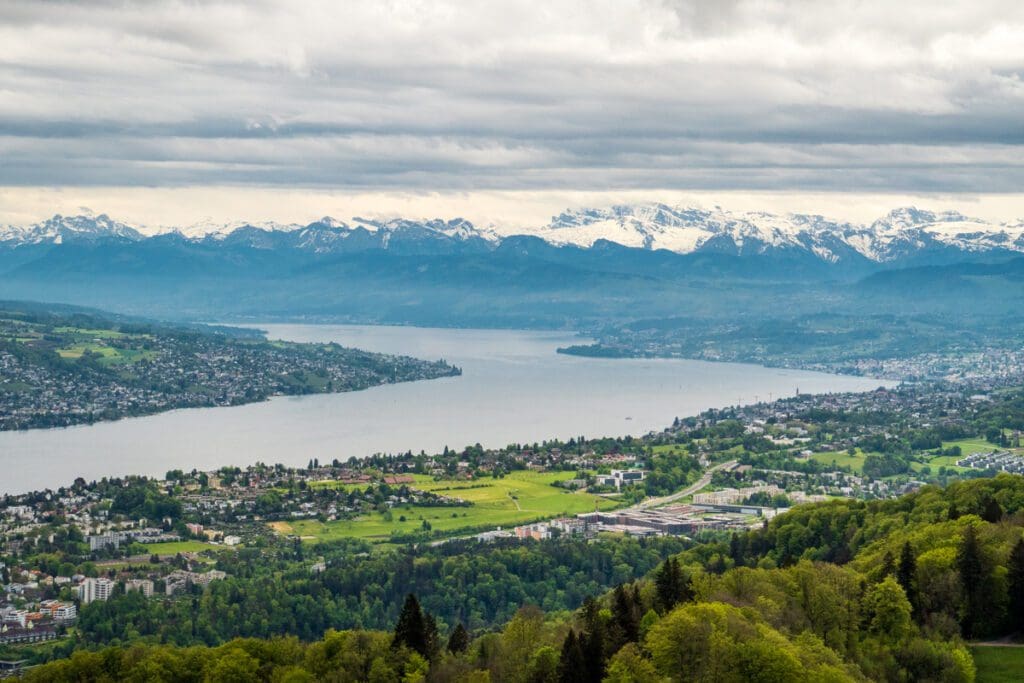
In Zurich, one of my favorite activities is to climb the Uetliberg. You can climb this small mountain to reach a tower that offers panoramic views of the city and the Alps.
You also must see the Lindenhof, where it is said an army of women came together to defend the city. These women were fully dressed in armor and appeared as a large army, which deterred enemies from attacking.
Day 15: Head to Germany to See the Neuschwanstein Castle

After spending two nights in Zurich, it is time to head to a new country, Germany. A great place to start in Germany is in the city of Fussen. Fussen is home to one of the most famous castles in the world, Neuschwanstein Castle. Chances are, you have seen an image of this castle on a calendar or a computer screen.
How to Access
It takes about 4 ½ hours by train to reach Fussen from Zurich. You will need to transfer at Buchloe, a small suburban city.
Where to Stay
Although Fussen is a small city, there are cheap hostels near the Neuschwanstein Castle. In Fussen, I recommend staying at the Old Kings Hostel. This small hostel has 24-hour check-in and cozy bunks. It is located in the heart of Fussen with many tourist shops and restaurants.
What to Do
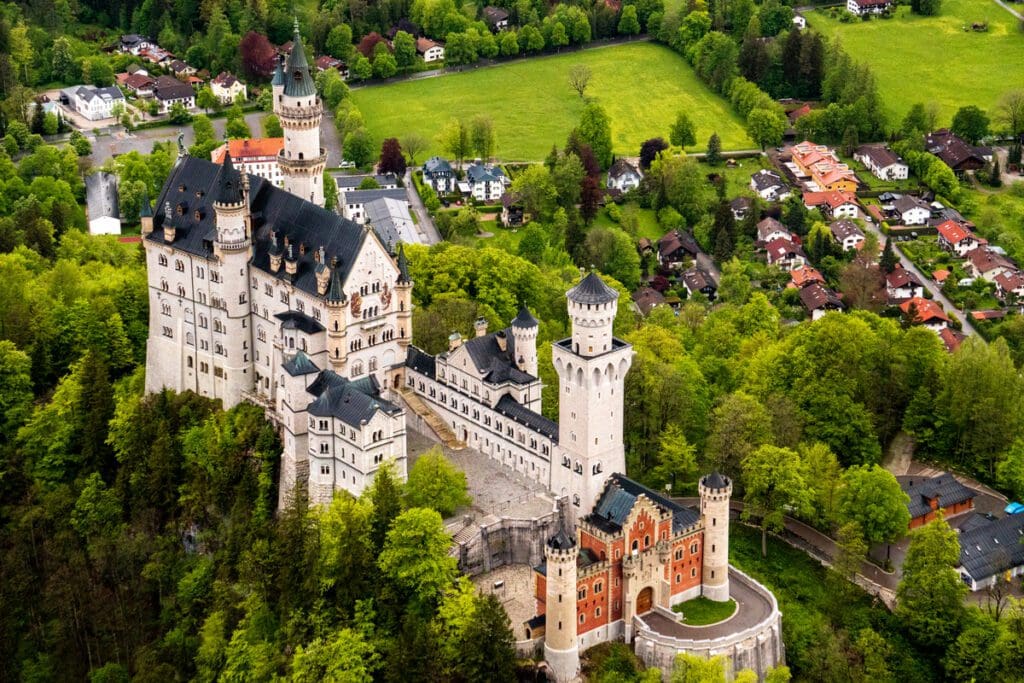
Of course, when you are in Fussen, you must tour Neuschwanstein Castle. Although the castle appears medieval, it is not even 200 years old. During the castle tour, you can learn more about the home of the bizarre King Ludwig II. I recommend purchasing tickets online at least a month before your visit because they sell out.
Touring the inside of the castle is exciting, but I also recommend hiking around the castle to escape the crowds that quickly accumulate around the castle. You can hike from Schloss Hohenschwangau, another castle in Fussen, to an expansive overlook of Neuschwanstein. Here is the trail map.
Day 16-17: Take the Train to Munich and Prague
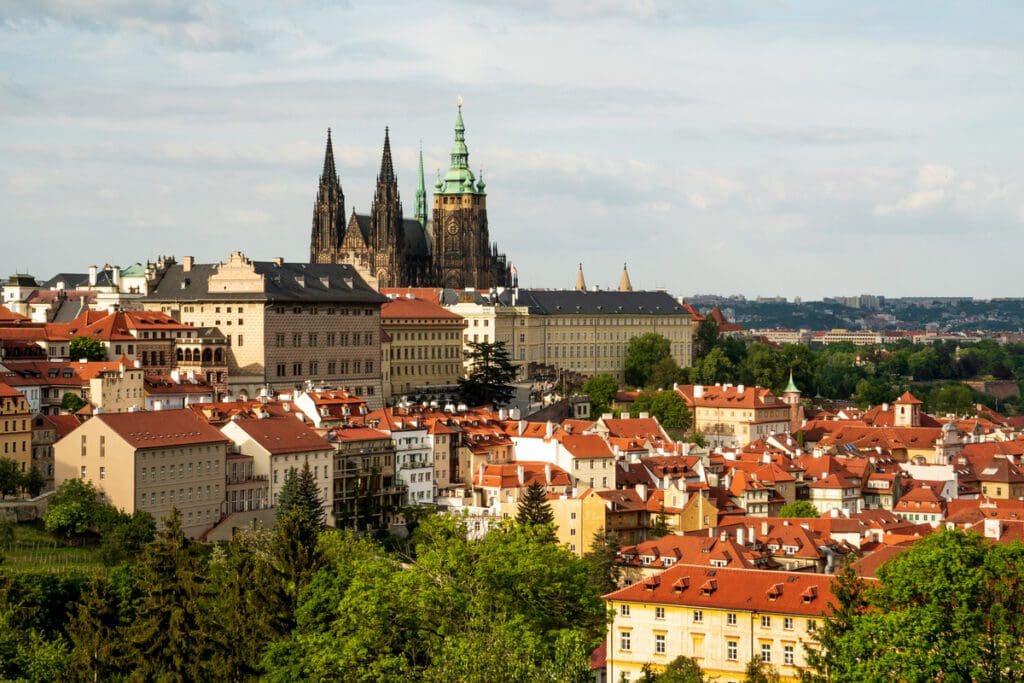
After spending a night in southern Germany, it is time to head northeast. Prague, the capital of the Czech Republic, is a scenic castle city worth at least a full day of exploring. However, I recommend staying in Prague for at least two nights.
On your way to Prague, you can stop in Munich, Germany, to eat at Viktualienmarkt. I also recommend climbing the bell tower at St. Peter’s catholic church. The view of Munich from the top of the church is breathtaking.
How to Access
From Fussen, it takes 2 hours to reach Munich without a train reservation. From Munich to Prague, you can take a 5 ½ hour direct train to the stunning capital of the Czech Republic. You also do not need a seat reservation for this train if you have a Eurail pass.
Where to Stay
I recommend staying at the Hostel Little Quarter in Prague. This friendly, spacious hostel is a great place to meet people. It has a large patio and kitchen. The rooms are also large and inviting.
Hostel Little Quarter is a few minutes away from Prague’s most popular tourist destination, the Prague Castle. So, you can wake up and quickly reach the castle before most tourists come later in the morning.
What to Do
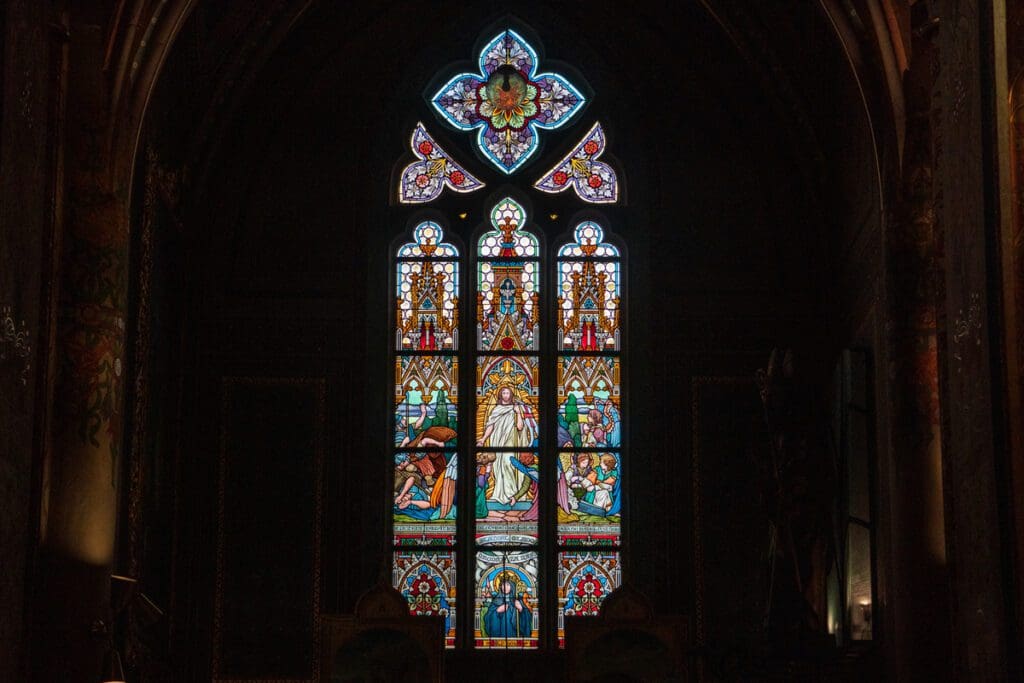
Besides touring the famous Prague Castle, I suggest walking the Charles Bridge (early in the morning) and going to Vysehrad, a free fortress that sees fewer tourists than most attractions in Prague.
During golden hour, make your way to the Petřín Gardens, an expansive hillside garden that offers many viewpoints of Prague.
Day 18-19: Go back to Germany and Visit Berlin
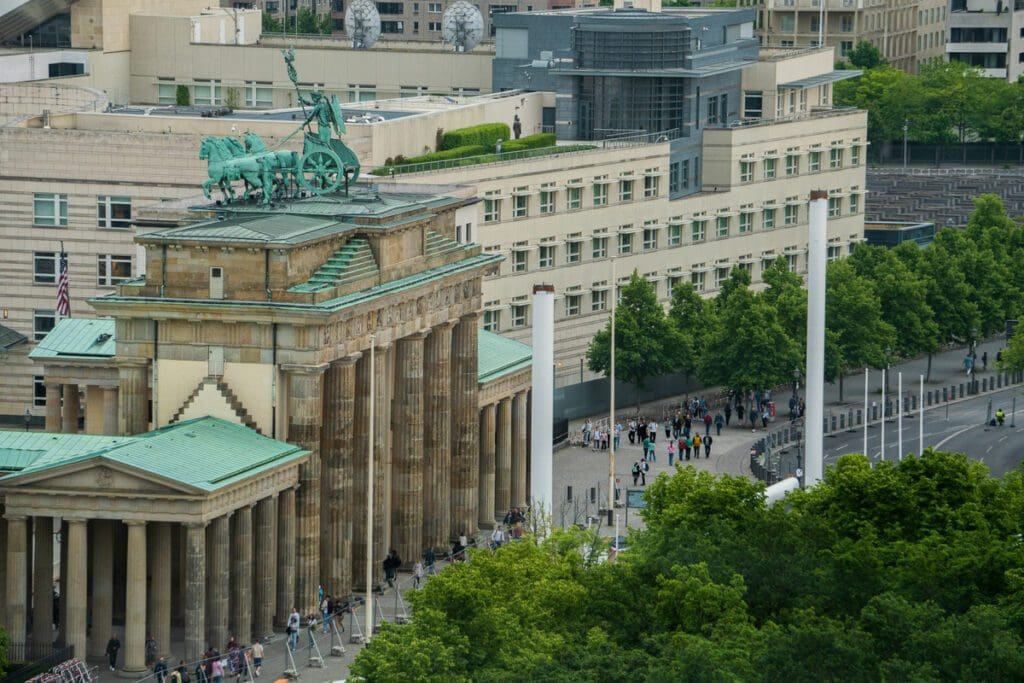
Although I already listed Germany in my one month Europe backpacking itinerary, on Day 16, it is time to return to Germany. This time to tour Berlin, the most popular city in the European Union. Berlin is the first stop on the back way to Western Europe in this itinerary for backpacking Europe in a month.
I also recommend stopping in Dresden on your way to Berlin from Prague. Dresden is a popular place for tourists and German locals. It is home to the Frauenkirche Dresden. This church collapsed during World War II and was rebuilt using some of the old, blackened bricks from the war.
How to Access
It takes 2 ½ hours to reach Dresden from Prague. Then, from Dresden to Berlin, it takes less than 2 hours. These trains do not require seat reservations.
Where to Stay
In Berlin, I stayed at Generator Berlin Mitte, because they offer rooms with sleeping pods. I find I always sleep better when I have my own pod. I enjoy the added privacy that comes with staying in a pod.
You can rent a bike for 12 Euros at Generator Berlin Mitte, which is a fantastic way to get around Berlin. Also, this hostel holds many activities throughout the week, making it a great hostel for travelers who want to be social during their trip.
What to Do
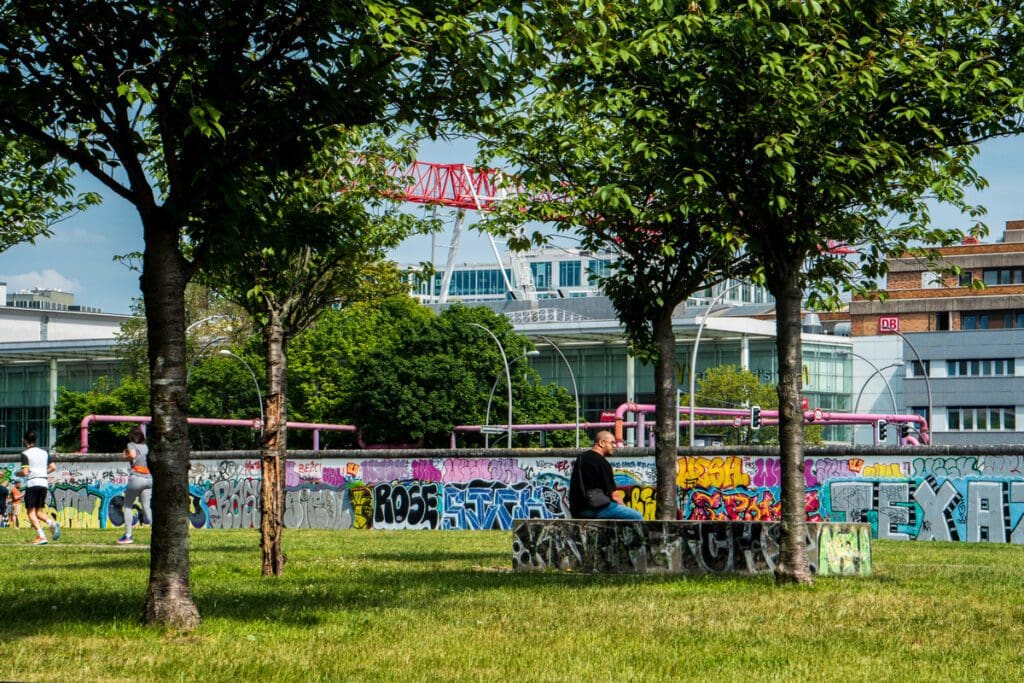
There is plenty to do and see in Berlin, so I suggest spending two full days in Berlin. You can start your day at the Berlin Wall Visitor Center and then bike to the hip Treptower Park. In the afternoon, you can read about WWII at the Topography of Terror and watch the sunset from the Berlin TV Tower.
Also, I highly recommend touring the Reichstag, a picturesque roof-top dome of the German Parliament. This tour is free! You just need to book tickets about one month in advance. If you have extra time, visit the Tempelhofer Feld, a vast abandoned airfield that now operates as a park, and eat doner at Mustafa Kebab.
Day 20: Spend the Day in Amsterdam

After taking in Berlin’s history, I recommend making Amsterdam your next stop. Amsterdam is known for its famed canals and windmills, but that is an incomplete picture of the Netherlands’ capital.
It has calming gardens and quiet shopping streets, perfect for a backpacker who wants to unwind after a month of solo traveling in Europe.
How to Access
The most budget-friendly way to get from Berlin to Amsterdam is to take an overnight train. You only need to transfer once during the 9-hour journey from Germany to the Netherlands. This is an efficient and cheap route if you can sleep comfortably on a train.
However, I always recommend booking a seat reservation when you take an overnight train so you are guaranteed to have a place to sleep on board. Some trains run from Berlin to Amsterdam during the day, but you will need to change trains at least 2 or 3 times.
Where to Stay
I recommend staying at Stayokay Hostel Amsterdam Vondelpark, located in an elegant neighborhood close to the Van Gogh Museum and Vondelpark. Stayokay has high ratings; many visitors say the hostel is very clean.
What to Do

When you are in Amsterdam, you must rent a bike. After all, it is one of the most famous cities in the world for biking. I highly recommend renting your bike from Frederic Rent a Bike because they also offer free luggage storage.
There are plenty of green spaces to bike to in Amsterdam, from Vondelpark to Rembrandtpark. You can visit Noordermarkt, a large market on Saturdays, Westelijke Eilanden, which offers great views of row houses, and the Jordaan neighborhood, a scenic district known for cafes and thrift stores.
Day 21: Explore Brussels
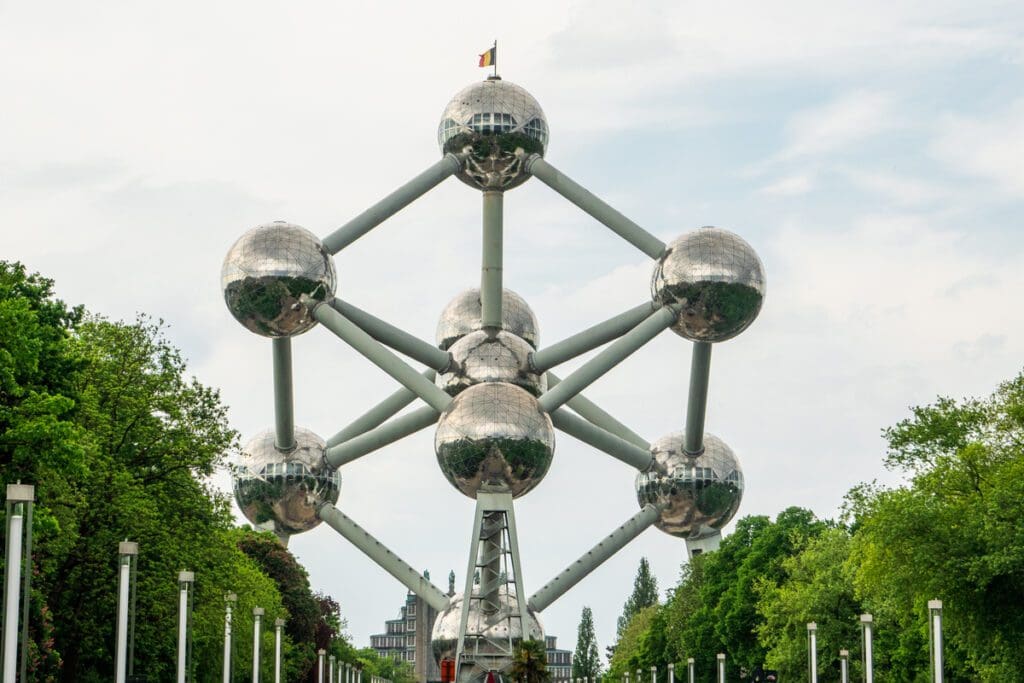
When I backpacked Europe for a month, I tried to visit as many countries as possible. Although Brussels isn’t the most exciting place to visit, I stopped here because it was easy to reach from Amsterdam and a convenient way to see Belgium.
Brussels is not spectacular, but there is enough to do for a day. I do not think you need more time in Brussels than one day unless you visit another city in Belgium.
How to Access
It is very easy to reach Brussels from Amsterdam. It takes less than three hours by train. On the Eurail Planner App, it says you need to pay an additional supplement fee to take this train. However, you do not need to pay this fee. The Eurail App is sometimes incorrect about supplemental fees.
Where to Stay
I stayed at Meininger Hotel Bruxelles Gare du Midi because it was affordable and close to the train station. It is not a bad place to stay for a night because it has nice facilities and a large common room.
What to Do
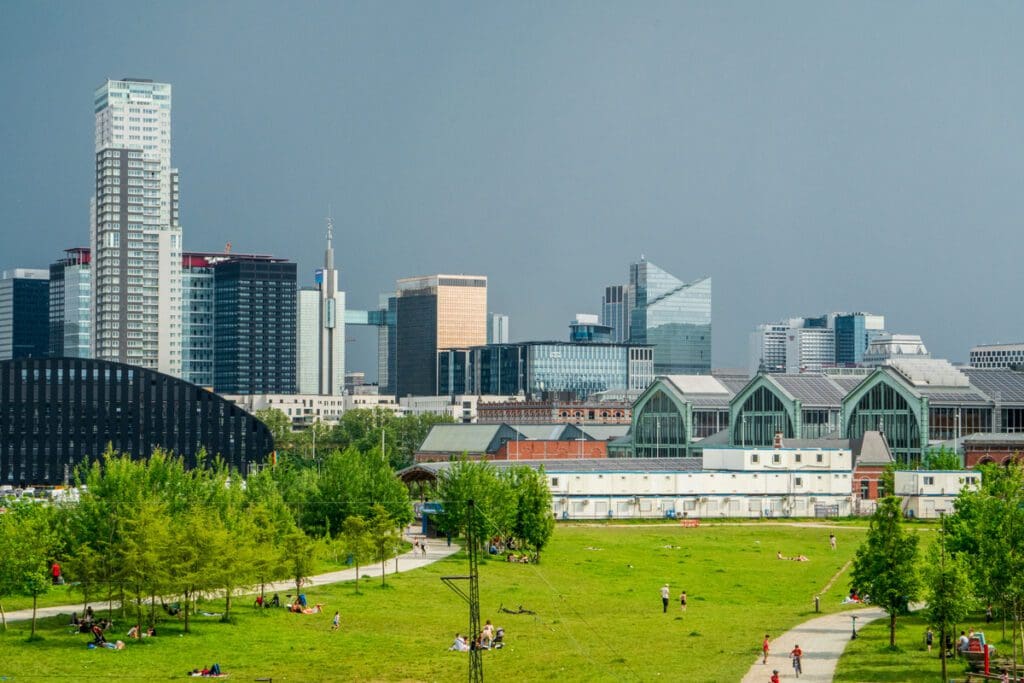
In my opinion, Brussels is a very “tourist-centered” city and lacks some authenticity. However, there are a few spots I recommend visiting in Brussels. If you visit Brussels on Sunday, you can enjoy Gare du Midi Market, one of the largest markets in Europe.
I recommend seeing St Michael and St Gudula Cathedral, Belgium’s national church. This Catholic cathedral is a great place to escape Brussels’s crowded shopping streets. Then, end your day at the Atomium, a historic stainless steel atom built for the 1958 World’s Fair. If you pay to go inside, beware of the long lines that accumulate at the elevators.
Day 22-24: Pass by Luxembourg and Then Paris
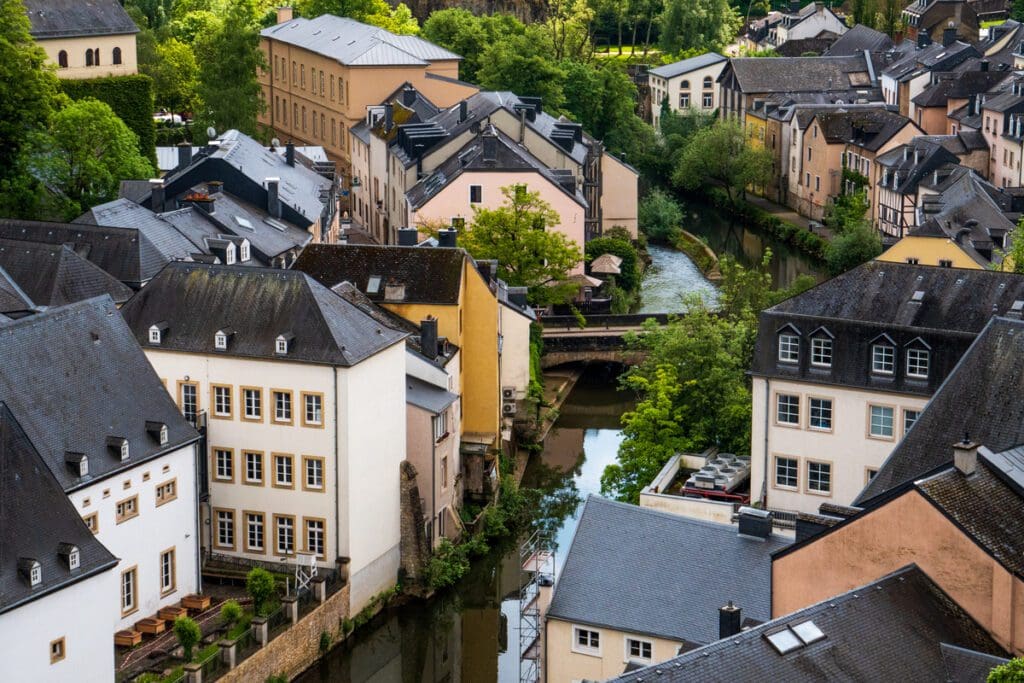
Most people who backpack Europe for a month do not stop in Luxembourg. However, since it is only 3 hours from Brussels, I recommend taking a detour in Luxembourg for a few hours before heading into Paris.
In Luxembourg, you cannot miss walking along the Chem. de la Corniche, a picturesque street with stunning views of the Neumünster Abbey. You should see the residence of the Grand Duke of Luxembourg before boarding your train to Paris.
How to Access
You can take a Eurocity train from Brussels to Luxembourg in 3 hours. From Luxembourg to Paris, you can take a 2 ½ hour train to Paris, but you will need to purchase a seat reservation on this train in addition to your Eurail Pass.
Where to Stay
In Paris, I stayed at Generator Paris. It is near a few different metro lines and is a great place to stay on a budget. However, this hostel has no kitchen and you cannot bring outside food in, which is not ideal for a backpacker.
What to Do
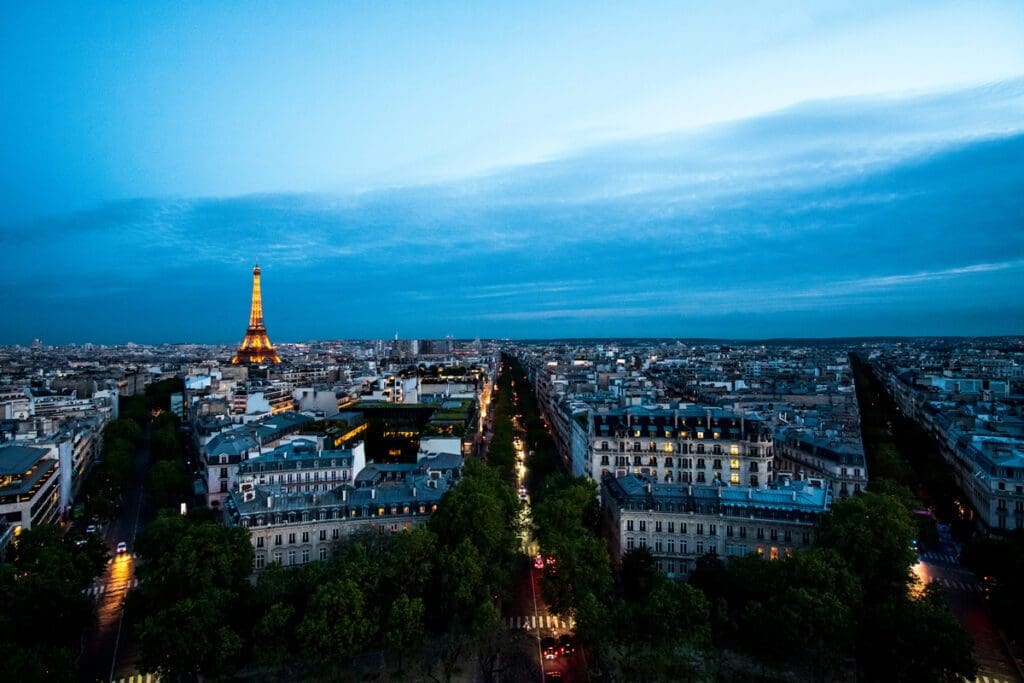
Paris is on nearly every itinerary for backpacking Europe in one month. France’s capital has been influential in history and culture for hundreds of years. Like every major city, some places are dirty or crowded, but overall, I really enjoyed my time in Paris.
Although it gets busy, you cannot miss watching the sunset from the Arc de Triomphe. The views of the Eiffel Tower from here are incredible. Also, you should stroll through Montmartre, relax in the Jardin du Luxembourg, and book an audio tour at Musée de l’Orangerie.
Day 24-26: Take in Museums and Music in London
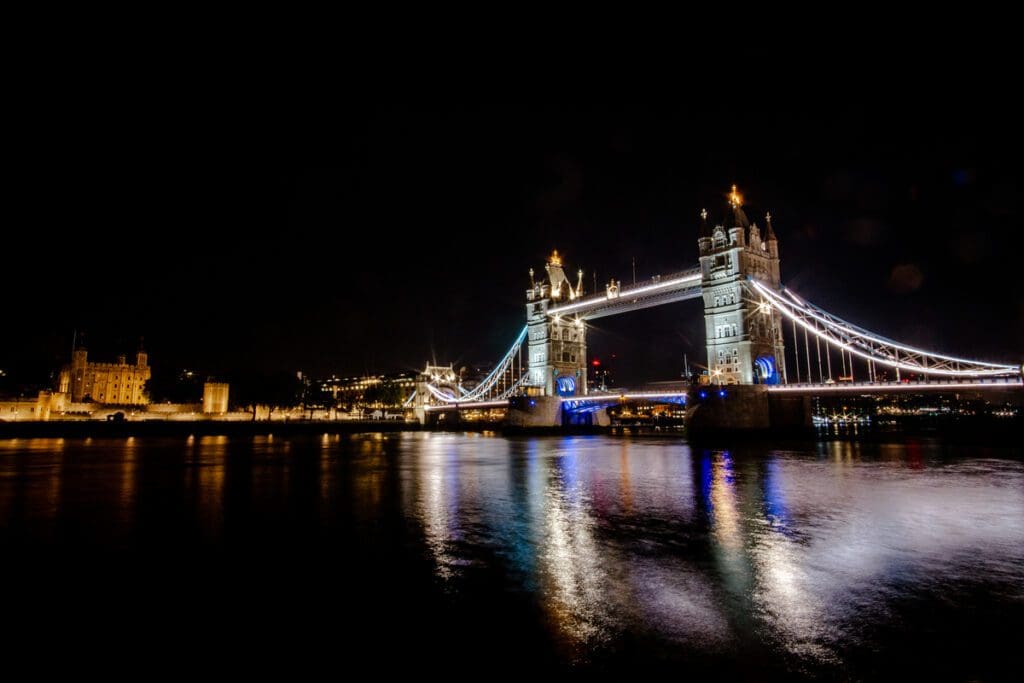
After two nights in Paris, you will head to London, another city that attracts millions of travelers yearly. Thanks to the Eurostar, a train that travels under the English Channel, it is very easy to travel between the cities.
How to Access
You can use your Eurail Pass to take the Eurostar, but you need an additional seat reservation. Typically, seat reservations are less than 10 Euros, but a seat reservation on the Eurostar is at least 30 Euros.
Although the Eurostar is expensive, it is extremely fast and convenient. It only takes 2 ½ hours to get between London and Paris. Just arrive at the airport at least an hour before your train departs to get through security.
Where to Stay
London is one of my favorite cities in Europe, but it is also one of the most expensive cities in Europe. Luckily, I found a Clink621, a budget-friendly place to stay. This hostel is located only 9 minutes from the King’s Cross train station.
What to Do
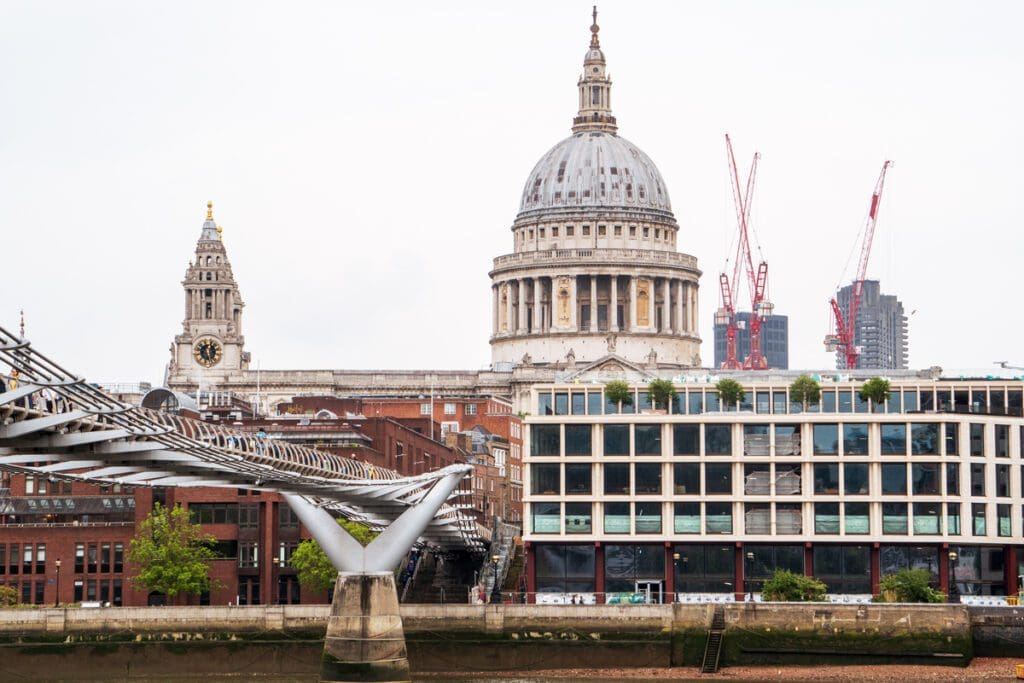
I only spent two nights in London, and you can easily spend a week here without getting bored. My favorite activities in London include biking in Hyde Park, going inside the free Westminster Cathedral, and taking pictures of the Tower Bridge at Potters Field Park.
Also, I highly suggest seeing Shakespeare at the Globe, going to Evensong at St. Paul’s Cathedral, and visiting the free Tate Modern Museum.
Day 27-29: Hike in Edinburgh and ride the train to Holyhead
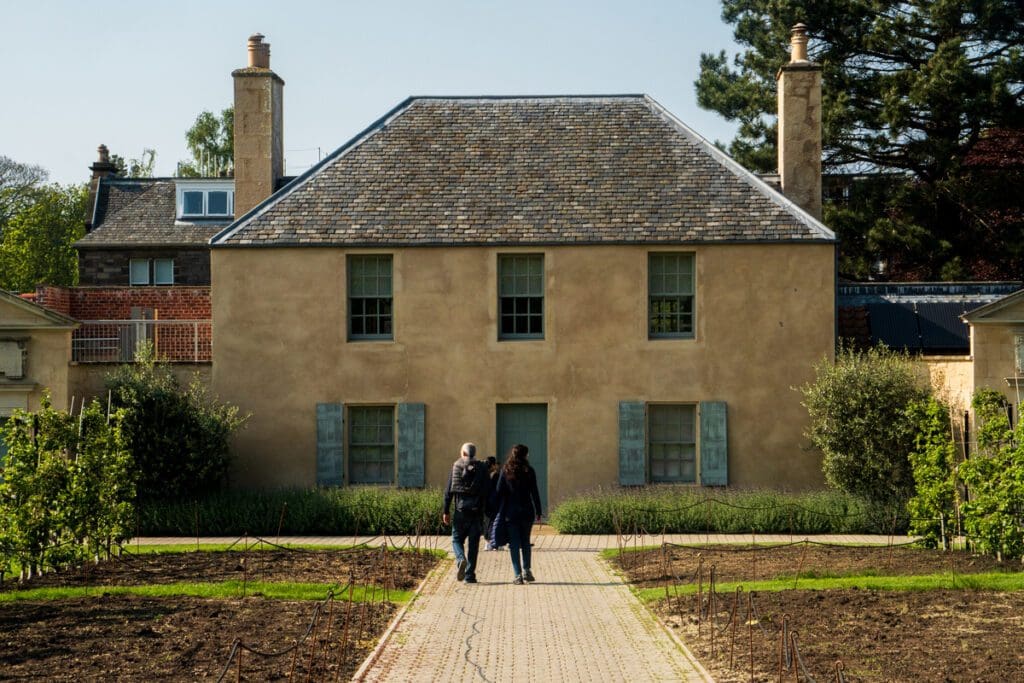
Your trip to the UK should not stop in London. I recommend taking the train north to Edinburgh, one of the most lively places in Scotland. After spending a few nights in Edinburgh, take your final train ride to Holyhead, Wales, to reach the final country on this itinerary.
How to Access
From London, it takes 6 hours by train to reach Edinburgh. You will only need to transfer once during this journey. If you have extra time, stop for a few hours in Durham. This quaint city is home to the Durham Castle, a 13th-century medieval castle famously used in the Harry Potter films.
Then, Edinburgh to Holyhead takes around 8 hours and requires at least two transfers. It is a long journey and a great way to see more of the English countryside.
Where to Stay
In Edinburgh, I stayed at Castle Rock Hostel. This hostel is a 3-minute walk from Edinburgh Castle and has a homely atmosphere you won’t find at most hostels. Its rooms are full of antique furniture and art. It is also a very social hostel that hosts many pub crawls.
What to Do

The most famous thing to do in Edinburgh is to tour its 11th-century castle. However, I found Edinburgh’s most enjoyable activities revolved around nature. Relax in the free Royal Botanic Garden Edinburgh, and hike Arthur’s seat for sunset. This hike is one of my favorite hikes in my entire one-month Europe backpacking itinerary.
Day 30-31: Finish Your Europe Trip in Dublin
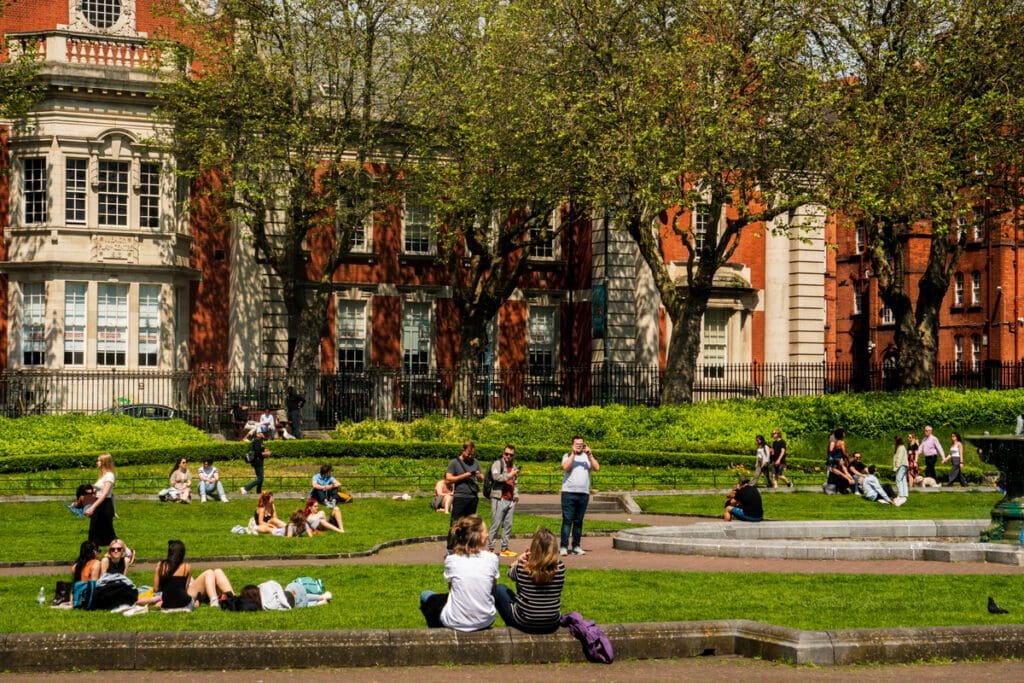
Once you take the train to Holyhead, Wales, you can easily access Dublin, Ireland, by ferry. Dublin is a great place to finish your month-long Europe trip because, typically, flights to the U.S. are cheaper from Dublin.
How to Access
From the Holyhead Ferry Terminal, take an Irish Ferry to Dublin. You can get a 30 percent discount on your ferry with a Eurail Pass. The journey from Holyhead to the Dublin Port takes about three hours. Once you arrive at the Dublin Port, you must take a quick bus ride to central Dublin.
Where to Stay
If you want to experience the true essence of staying in Dublin, book a night at Gogarty’s Temple Bar Hostel. Here, you can stay above an Irish pub in Dublin’s historic city center.
What to Do

Dublin revolves around its electric nightlife. However, I enjoyed my time in Howth, an upscale beach town less than 30 minutes from Dublin’s city center. In Howth, you should take the Cliff Walk and eat fish and chips from Beshoff Bros Howth.
The Perfect One-Month Europe Backpacking Itinerary
There is no perfect itinerary for backpacking Europe in one month. It is difficult trying to balance not rushing and maximizing your time.
You can completely follow my itinerary from start to finish, but I suggest making some changes based on your preferences. However, follow my advice on where to stay and what to do in each location to make planning your trip easier.